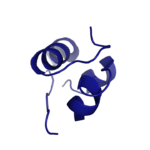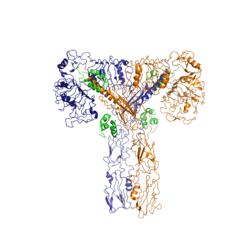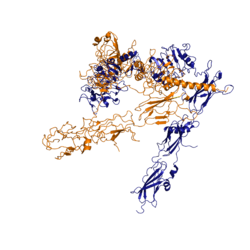Johnson's Monday Lab Sandbox for Insulin Receptor
From Proteopedia
(Difference between revisions)
| Line 11: | Line 11: | ||
The insulin receptor is a [http://en.wikipedia.org/wiki/Receptor_tyrosine_kinase receptor tyrosine kinase]. It is a [http://en.wikipedia.org/wiki/Heterotetramer heterotetramer] that is constructed from two [http://en.wiktionary.org/wiki/homodimer homodimers]. Each homodimer maintains an extracellular domain, transmembrane helix, and an intracellular domain. The insulin is divided into <scene name='83/839263/Alpha_and_beta_subunit/2'>alpha and beta</scene> [http://en.wikipedia.org/wiki/Protein_subunit subunits]. The alpha subunit is characterized by two leucine-rich regions and one cysteine-rich region. The beta subunit contains three fibronectin type III domains along with the transmembrane domain and intracellular tyrosine kinase domain that could not be shown in one continous PDB structure. The alpha and beta subunits of the extracellular domains fold over one another and form a <scene name='83/839263/V_shape/2'>"V" shape</scene> when the insulin receptor is inactivated. Upon activation, the extracellular domain undergoes a conformational change and forms a <scene name='83/839263/T-shape/3'>"T" shape</scene>. | The insulin receptor is a [http://en.wikipedia.org/wiki/Receptor_tyrosine_kinase receptor tyrosine kinase]. It is a [http://en.wikipedia.org/wiki/Heterotetramer heterotetramer] that is constructed from two [http://en.wiktionary.org/wiki/homodimer homodimers]. Each homodimer maintains an extracellular domain, transmembrane helix, and an intracellular domain. The insulin is divided into <scene name='83/839263/Alpha_and_beta_subunit/2'>alpha and beta</scene> [http://en.wikipedia.org/wiki/Protein_subunit subunits]. The alpha subunit is characterized by two leucine-rich regions and one cysteine-rich region. The beta subunit contains three fibronectin type III domains along with the transmembrane domain and intracellular tyrosine kinase domain that could not be shown in one continous PDB structure. The alpha and beta subunits of the extracellular domains fold over one another and form a <scene name='83/839263/V_shape/2'>"V" shape</scene> when the insulin receptor is inactivated. Upon activation, the extracellular domain undergoes a conformational change and forms a <scene name='83/839263/T-shape/3'>"T" shape</scene>. | ||
[[Image:Insulin Receptor T.png|thumb|right|250px|Figure 2: Insulin receptor in the active "T" shape conformation with four insulins bound]] | [[Image:Insulin Receptor T.png|thumb|right|250px|Figure 2: Insulin receptor in the active "T" shape conformation with four insulins bound]] | ||
| - | An additional component to the [http://en.wikipedia.org/wiki/Ectodomain ectodomain] is the <scene name='83/839263/Alpha-ct/2'> ''alpha'' chain C-terminal helix</scene>, which is also referred to as the "''alpha''-CT" <ref name= "Uchikawa" />. Each of the dimers has an "alpha"-CT. The ''alpha''-CT is a single alpha-helix and it plays an important role in insulin binding and stabilization of the "T" shape activated conformation. The ''alpha''-CT interacts with a leucine-rich region of the alpha subunit and a fibronectin type III region of the beta subunit to form the insulin binding sites known as site 1 and site 1' <ref name="Uchikawa" />. | + | An additional component to the [http://en.wikipedia.org/wiki/Ectodomain ectodomain] is the <scene name='83/839263/Alpha-ct/2'> ''alpha'' chain C-terminal helix</scene>, which is also referred to as the "''alpha''-CT" <ref name= "Uchikawa" />. Each of the dimers has an "alpha"-CT. The ''alpha''-CT is a single alpha-helix and it plays an important role in insulin binding and stabilization of the "T" shape activated conformation. The ''alpha''-CT interacts with a leucine-rich region of the alpha subunit and a fibronectin type III region of the beta subunit to form the insulin binding sites known as <scene name='83/839263/Insulin_molecules_at_site_1/1'>site 1 and site 1'</scene> <ref name="Uchikawa" />. |
The structure of the extracellular domain is stabilized through [http://en.wikipedia.org/wiki/Covalent_bond covalent bonds]. The alpha subunits are linked through two disulfide bonds, with the main one being between <scene name='83/839263/Cys_holding_alphas_together/2'>Cys524</scene> of one alpha subunit and <scene name='83/839263/Cys_holding_alphas_together/2'>Cys524</scene> of the other alpha subunit <ref name="Schäffer" />. <scene name='83/839263/Cys_683_holding_alphas_togethe/2'>Cys683</scene> of both alpha subunits hold the two together with a disulfide bond <ref name="Sparrow" />. The alpha subunit is held to the beta subunit by a disulfide bond between the <scene name='83/839263/Alpha_beta_link_by_disulfide/4'>Cys647 of the alpha subunit and Cys872 of the beta subunit</scene><ref name="Sparrow" />. | The structure of the extracellular domain is stabilized through [http://en.wikipedia.org/wiki/Covalent_bond covalent bonds]. The alpha subunits are linked through two disulfide bonds, with the main one being between <scene name='83/839263/Cys_holding_alphas_together/2'>Cys524</scene> of one alpha subunit and <scene name='83/839263/Cys_holding_alphas_together/2'>Cys524</scene> of the other alpha subunit <ref name="Schäffer" />. <scene name='83/839263/Cys_683_holding_alphas_togethe/2'>Cys683</scene> of both alpha subunits hold the two together with a disulfide bond <ref name="Sparrow" />. The alpha subunit is held to the beta subunit by a disulfide bond between the <scene name='83/839263/Alpha_beta_link_by_disulfide/4'>Cys647 of the alpha subunit and Cys872 of the beta subunit</scene><ref name="Sparrow" />. | ||
Revision as of 18:12, 16 April 2020
Insulin Receptor
| |||||||||||



